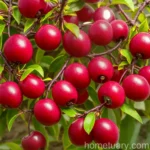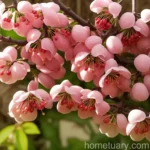Apricot (Prunus armeniaca ‘Zaiglo’ STARK GOLDEN GLO)
What is an Apricot?
Apricot, scientifically known as Prunus armeniaca, is a species of fruit-bearing tree belonging to the Rosaceae family. It is widely cultivated for its delicious and nutritious fruits, also known as apricots. The ‘Zaiglo’ STARK GOLDEN GLO is a specific cultivar of apricot that is highly valued for its exceptional fruit quality and yield.
Key Takeaways
Apricot (Prunus armeniaca ‘Zaiglo’ STARK GOLDEN GLO)
- The ‘Zaiglo’ STARK GOLDEN GLO is a specific cultivar of apricot.
- It belongs to the Prunus armeniaca species and is known for its exceptional fruit quality and yield.
Culture
Uses
The apricot tree and its fruits have various uses:
- Culinary purposes: Apricots are used fresh, dried, or for making jams, preserves, and baked goods.
- Nutritional benefits: Apricots are rich in vitamins, fiber, and antioxidants, offering numerous health benefits.
- Ornamental value: The apricot tree also holds ornamental value due to its beautiful blossoms and foliage.
Water
Water is vital for the growth and development of apricot trees. Proper irrigation is essential, especially during the flowering and fruit development stages. Adequate water supply helps in preventing fruit drop and promoting optimal fruit size and quality.
Sunlight
Apricot trees thrive in full sunlight. They require at least 6-8 hours of direct sunlight daily for optimal growth, flowering, and fruit production. Adequate sunlight exposure also contributes to the development of flavorful and sweet fruits.
Fertilizer
Fertilization plays a crucial role in the cultivation of apricot trees. A balanced fertilizer with a higher proportion of nitrogen is beneficial for promoting healthy foliage and overall tree growth. Additionally, the fertilizer should provide essential nutrients such as phosphorus and potassium to support fruit development and enhance fruit quality.
Soil
Apricot trees prefer well-drained soil with a slightly acidic to neutral pH. Loamy or sandy loam soils are ideal for apricot cultivation as they offer good drainage while retaining sufficient moisture. Soil that is rich in organic matter and nutrients is essential for fostering healthy root development and overall tree vigor.
Pruning
Pruning is an important cultural practice for apricot trees:
- Structural pruning: It helps in shaping the tree, removing dead or damaged wood, and promoting an open canopy for adequate sunlight penetration and air circulation.
- Fruit-bearing wood selection: Proper pruning encourages the growth of fruit-bearing wood, leading to improved fruit production and quality.
Propagation
Apricot trees can be propagated through various methods:
- Seed propagation: Though viable, seed propagation is less common due to the variability in seedling traits.
- Grafting or budding: This method is widely used to propagate apricot trees, using desirable cultivars as scions grafted onto suitable rootstocks.
Container Popularity
Apricot trees can be grown in containers, making them suitable for small gardens or urban settings. Container-grown apricots require proper care, including regular watering, fertilization, and occasional root pruning to maintain tree vigor and fruiting.
Common Diseases
Disease Diagnosis
Apricot trees are susceptible to various diseases, including:
- Bacterial canker: Characterized by oozing lesions on the bark, leading to branch dieback and reduced fruit production.
- Brown rot: Causes fruit rot and blossom blight, resulting in fruit decay and loss.
- Powdery mildew: A fungal disease that affects foliage and young shoots, leading to powdery white growth and impaired photosynthesis.
Common Pests
Several pests can infest apricot trees, including:
- Aphids: They feed on sap, causing leaf distortion and reduced tree vigor.
- Fruit moths: Their larvae tunnel into fruits, leading to damage and reduced fruit quality.
- Scale insects: They can affect tree health, leading to stunted growth and honeydew production.
Botanist’s Tips
- Select disease-resistant cultivars: Choose apricot cultivars known for their resistance to common diseases and pests.
- Monitor tree health: Regularly inspect trees for signs of diseases or pest infestations and promptly address any issues.
- Provide proper care: Ensure that apricot trees receive adequate water, sunlight, nutrients, and proper cultural practices to maintain tree vigor and fruit production.
Fun Facts
- Apricot trees belong to the Prunus family, which also includes cherries, plums, and almonds.
- The apricot is known for its early spring blossoms, producing beautiful and fragrant pink or white flowers.
Links to External Resources
For additional information on apricot tree care, diseases, and cultivation techniques, refer to the following resources:
- Apricot Growing Guide
- Prunus armeniaca ‘Zaiglo’ STARK GOLDEN GLO Information
- Apricot Tree Care and Maintenance
In conclusion, the apricot, particularly the ‘Zaiglo’ STARK GOLDEN GLO cultivar, is a valuable fruit tree known for its delicious fruits and ornamental value. By understanding its cultural requirements, common diseases, and pest management strategies, growers can successfully cultivate healthy and productive apricot trees.
I hope you found this comprehensive guide on apricot (Prunus armeniaca ‘Zaiglo’ STARK GOLDEN GLO) helpful for your gardening endeavors.















